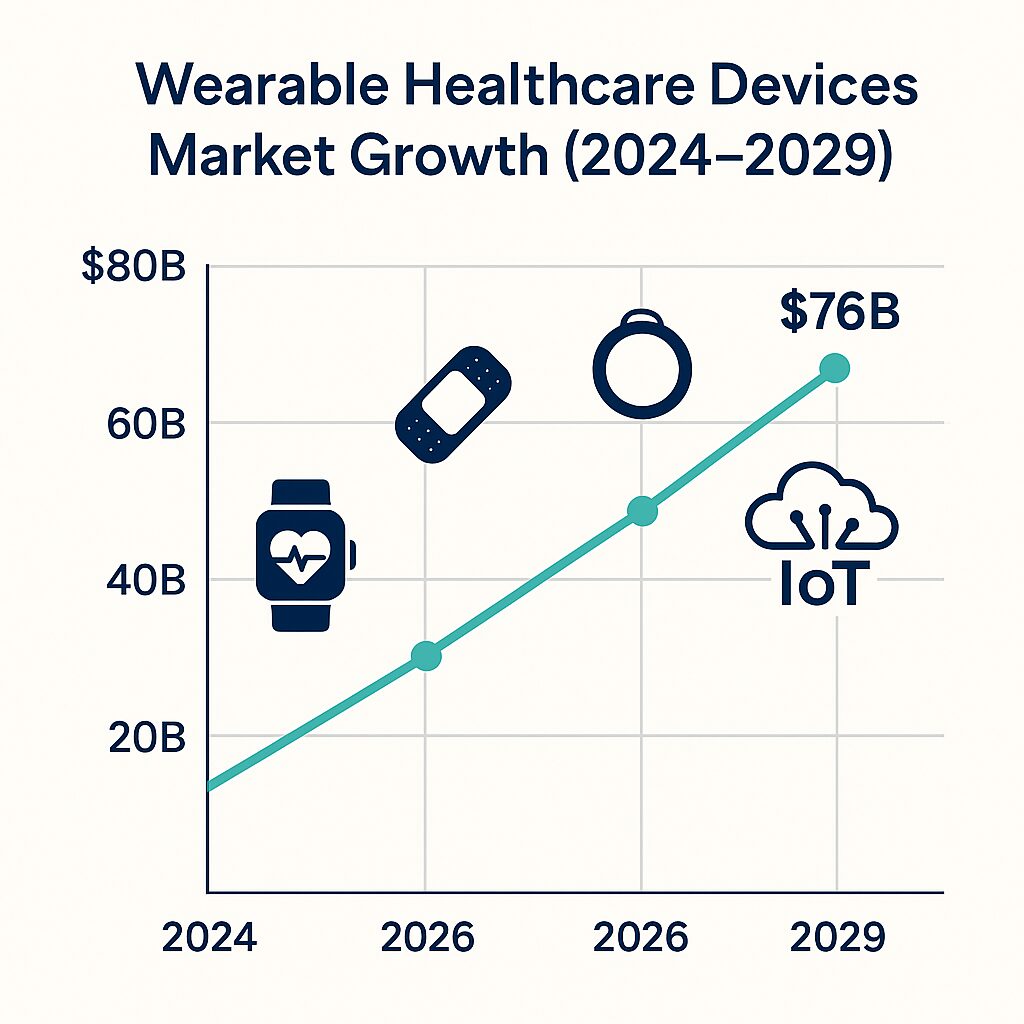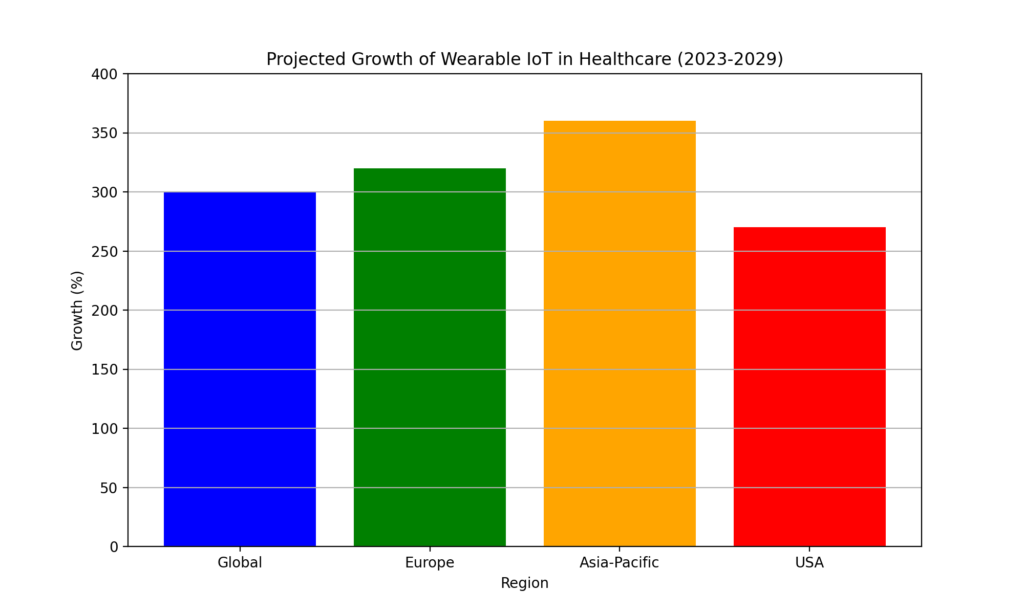-
Sabreen Akhtar
- Reading Time: 20 Min

Section 1: Introduction
As healthcare becomes increasingly digital, IoT wearable devices are quickly shifting from consumer novelties to indispensable tools in clinical settings. These devices capture real-time biometric data, enabling clinicians to monitor patients outside of hospitals and empower individuals to manage chronic illnesses more effectively. For a wearable health start-up, this evolution presents a massive opportunity to disrupt traditional care models and build scalable, high-impact solutions.
The need for smarter health tools is driven by rising global healthcare costs, the aging population, and the prevalence of chronic diseases. According to Statista the market for wearable healthcare devices reached over $30 billion in 2024 and is forecasted to surpass $76 billion by 2029—a compound annual growth rate exceeding 15%.
Reference List Entry (APA style example):
Statista. (2024). Wearable healthcare devices market worldwide. Statista. https://www.statista.com/statistics/1461215/wearable-healthcare-devices-market-worldwide/

Reference: OpenAI. (2023). ChatGPT (Version 4.0) [Large language model]. OpenAI. https://openai.com/chatgpt
These numbers don’t just reflect increased demand but also signal the readiness of the healthcare ecosystem to integrate wearable electronics in IoT.
For startups, this wave of transformation is both a challenge and an open runway. It requires balancing medical-grade accuracy with ease of use, regulatory compliance with speed to market, and patient privacy with real-time analytics. As we’ll explore, the advantages of IoT in healthcare—ranging from early disease detection to operational cost savings—are too compelling to ignore.
In this article, we break down:
- Why IoT wearables are a cornerstone of future healthcare systems
- The technical and clinical benefits of IoT in healthcare
- Real-world examples of IoT wearable devices
- Challenges in data security, adoption, and compliance
What the next decade holds for wearable devices in IoT
Section 2: The Evolution and Market Drivers of IoT in Healthcare
The idea of using wearable devices for health monitoring isn’t new—but recent leaps in technology have made them more powerful and practical than ever before. In the past decade, IoT wearable devices have evolved from simple pedometers to sophisticated tools capable of tracking ECG, blood oxygen, glucose levels, skin temperature, stress biomarkers, and even neurological patterns.
What’s fueling this momentum? Several converging trends:
1. Sensor Innovation & Miniaturization
Sensors are becoming smaller, cheaper, and more precise. From optical heart rate monitors to electrodermal activity sensors that detect stress, today’s wearable electronics in IoT offer medical-grade accuracy in user-friendly formats. These components can now be embedded into watches, rings, patches, smart socks, and even tattoos.
2. AI and Real-Time Data Processing
Modern IoT wearable devices are often paired with machine learning algorithms that can recognize health patterns and detect anomalies. This is critical for identifying early signs of disease or tracking chronic conditions with greater nuance than episodic visits allow.
3. Demand for Preventive and Personalized Care
Patients today are more informed and proactive about their health. At the same time, providers are shifting toward value-based care models that reward prevention over intervention. IoT-powered remote monitoring enables continuous care and data-informed decisions.
4. Chronic Disease Burden
According to the CDC, 60% of adults in the U.S. have at least one chronic disease. These conditions account for 86% of total healthcare costs. IoT wearable devices allow for better management of hypertension, diabetes, heart disease, and more—outside the clinic.
Reference:
Centers for Disease Control and Prevention. (2023). About Chronic Diseases. Centers for Disease Control and Prevention. https://www.cdc.gov/chronic-disease/about/index.html
5. COVID-19 and the Remote Care Boom
The pandemic accelerated telehealth and digital health adoption. Suddenly, advantages of IoT-based health monitoring systems—like contactless tracking, remote diagnostics, and early alerts—became essential, not optional.
Together, these forces have created a perfect storm for innovation, with wearable devices in IoT at the center.

This chart displays the projected growth percentages for Europe, Asia-Pacific, the USA, and the global total market from 2023 to 2029.
Reference for Image: Created using Julius AI, sourced from https://blog.urlaunched.com/wearable-iot-development-for-healthcare-startups/.
Section 3: Key Benefits of IoT Wearable Devices in Healthcare
1. Continuous, Real-Time Health Monitoring
Unlike traditional devices that offer a snapshot, IoT wearable devices capture ongoing biometric data. This enables timely interventions and a better understanding of disease progression.
For example:
- A CGM (Continuous Glucose Monitor) can track a diabetic’s glucose levels 24/7.
- A smart blood pressure cuff can notify clinicians of dangerous fluctuations without requiring a visit.
- IoT health bracelets can track stress levels and hydration in real-time.
2. Early Disease Detection and Risk Prediction
By leveraging AI algorithms and longitudinal data, wearables can detect early warning signs of disease—well before traditional methods. This is especially relevant in cardiovascular health, where 80% of deaths are considered preventable.
Examples include:
- Irregular heartbeats detected through wearable ECGs
- Sleep apnea warnings from respiratory monitors
- Fall risk assessments via gait and motion sensors
3. Enhanced Patient Compliance
One of the underestimated benefits of IoT in healthcare is behavioral reinforcement. Devices can remind patients to take medication, log meals, or get up and move—helping users stick to treatment plans. Smart pill bottles and IoT wearable devices tied to inhalers or insulin pumps are already improving adherence.
4. Remote Patient Monitoring (RPM) and Telehealth Integration
Clinicians can now monitor patients at home without compromising care quality. RPM solutions reduce hospital readmissions, improve chronic care, and free up in-clinic resources.
For startups, this is a huge opportunity: building platforms that connect wearable devices in IoT with telehealth dashboards, EMRs, and analytics engines.
5. Personalized Medicine and Context-Aware Insights
Generic care plans often fall short. A 10,000-step goal, for instance, might be harmful to a cardiac patient but underwhelming for a fitness enthusiast. IoT wearable devices, by collecting individualized data, can offer tailored recommendations that consider a user’s condition, history, and context.
6. Data Collection for Research and AI Models
Wearables collect real-world data at a scale never before possible. This feeds back into clinical research, algorithm development, and AI-based diagnostics—fueling the next generation of predictive tools
7. Operational Cost Reduction
From reducing hospital stays to minimizing ER visits, the cost-saving potential of IoT-based health monitoring systems is massive. One McKinsey study noted that cardiac monitoring patches are 90% cheaper than implantable loop recorders.
Understanding the costs involved in developing wearable IoT devices is crucial for strategic planning.

The chart visualizes the costs associated with different approaches to developing wearable IoT devices.
Reference for Image: Created using Julius AI, sourced from https://blog.urlaunched.com/wearable-iot-development-for-healthcare-startups/.
Section 4: Real-World Applications of Wearable Electronics in IoT
Wearable devices in IoT come in various forms, each serving a different purpose across patient types and care stages:
A. Consumer Wellness Devices
- Smartwatches and IoT health bracelets: Track heart rate, stress, sleep, and activity.
- Fitness rings (e.g., Oura): Analyze temperature, movement, and sleep stages.
- Smart apparel: Monitors posture, exertion, and hydration during workouts.
These devices focus on general wellness but are increasingly used in clinical research and preventative programs.
B. Medical-Grade Devices
These require regulatory oversight and are often integrated with EHR systems or used in remote monitoring programs:
- CGMs with automated insulin delivery
- Wearable ECG patches for arrhythmia detection
- Neurostimulators and drug delivery patches
- Smart prosthetics with motion sensors for rehabilitation
- Exoskeletons for mobility training
C. Rehabilitation and Chronic Disease Management
Devices such as smart gloves and FES (functional electrical stimulation) systems help patients with stroke, paralysis, or Parkinson’s disease regain mobility.
D. Screening and Diagnostics
Wearables are now used for early screening of sleep disorders, cardiovascular abnormalities, and even breast cancer (via ultrasound patches).
This breadth of application makes the advantages of IoT-based health monitoring systems valuable across nearly every stage of care.
Section 5: Technical and Regulatory Challenges for Startups
Despite the promise, building a successful wearable health start-up is no easy task. Key challenges include:
1. Data Accuracy and Reliability
Even minor fluctuations in sensor readings can lead to misdiagnosis. Factors like sweat, skin contact, battery life, and environmental interference can distort signals. Startups must use advanced noise-reduction algorithms and rigorous validation testing.
2. Security and Privacy
IoT wearable devices collect highly sensitive health data. HIPAA, GDPR, and MDR regulations require:
- End-to-end encryption
- Data minimization
- Secure APIs and servers
- Role-based access controls
Any breach can severely damage trust and lead to regulatory fines.
3. Interoperability and Integration
Different healthcare providers use different data standards (FHIR, HL7, etc.). If a wearable cannot integrate with these systems, its usefulness is limited. Building APIs and ensuring data mapping is essential.
4. Regulatory Hurdles
Depending on functionality, a wearable may require FDA or CE approval. This means startups must invest in:
- Quality management systems (ISO 13485)
- Clinical validation trials
- Ongoing risk assessments
The trade-off? Greater credibility and access to institutional buyers.
5. User Adoption Barriers
Cost, complexity, and comfort are major friction points. Devices must be intuitive, non-invasive, and affordable. Accessibility for elderly or disabled users also needs to be factored in.
For example, IoT health bracelets used in remote care must support various languages, include onboarding tutorials, and operate with minimal internet requirements.
Section 6: Future Trends and Opportunities
Looking ahead, the next wave of IoT wearable devices will be even more immersive, intelligent, and invisible.
• Wearable AI
On-device processing will reduce latency and preserve privacy. AI will be used to assess anomalies instantly, without cloud dependency.
• Smart Tattoos and E-Skin
These ultra-thin sensors can track temperature, hydration, glucose, and more—perfect for pediatrics and elderly care.
• Smart Clothing
Embedded with stretchable sensors, garments will monitor respiration, posture, and metabolic activity during daily life.
• Women’s Health Wearables
From fertility tracking to hormonal monitoring, wearables targeting female-specific health concerns are gaining traction.
• Expanded Use in Behavioral Health
Biosensors tracking emotional states will be integrated into mental health platforms, supporting interventions for anxiety, depression, or ADHD.
• Device Ecosystems
Future wearables will communicate with each other—creating a comprehensive picture from wrist to chest to ankle. Expect wearable devices in IoT to be part of multi-device networks delivering unified health intelligence.
Conclusion
The benefits of IoT in healthcare are clear: personalized, proactive, and data-rich care that can scale globally. For any wearable health start-up, the path to success involves more than just hardware. It’s about building systems that are interoperable, clinically validated, and user-centric.
Yes, the technical and regulatory landscape is complex. But for those willing to invest in precision, security, and usability, the payoff is immense. As the market accelerates, IoT wearable devices will become the connective tissue of modern healthcare — enabling outcomes that were unthinkable just a decade ago.